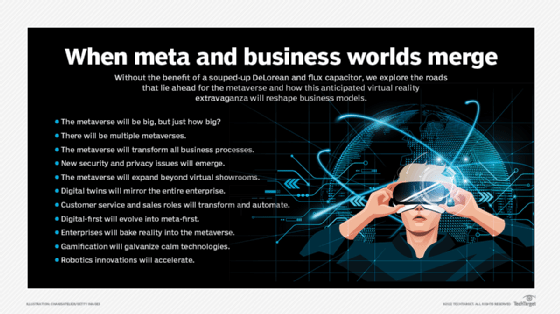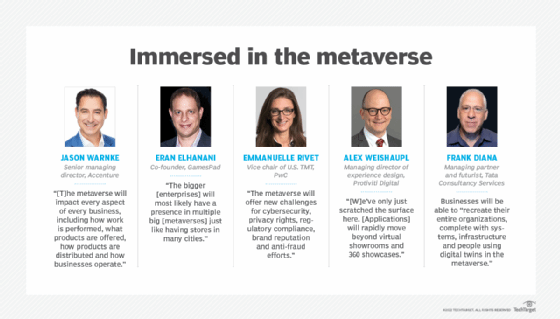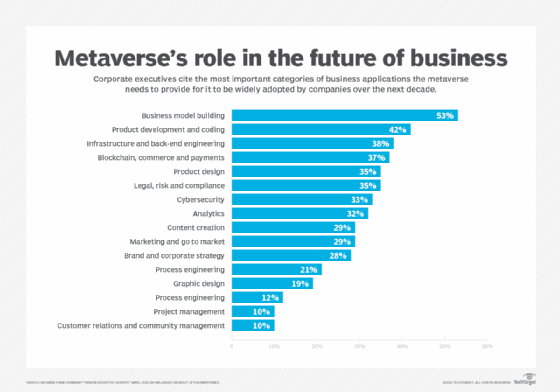
Getty Images
12 top metaverse predictions for 2030
Like AI before it, the metaverse carries unlimited potential and hyperbole. We address the questions of how big, how fast, how far, how scary and how impactful on businesses.
Business leaders, marketing teams and pundits are all abuzz about the next advent of the metaverse, built on an assortment of 3D technology, real-time collaboration and decentralized finance tools. It promises to change how we work, play and interact on the internet.
The consumer-oriented manifestation of the metaverse will evolve from early roots in social media, massive multiplayer games and more immersive commerce. The business-oriented side will encompass tools for remote work, IoT, digital twins, computer-aided design, 3D printing and business applications. Along the way, the metaverse must navigate various challenges surrounding privacy, security, hardware and networking latency. Progress will likely evolve in fits and starts that mirror early efforts to get mobile off the ground before the iPhone created a template for the mobile industry.
What is the metaverse?
At a broad level, the metaverse represents the intersection of 3D immersive experiences, persistent shared environments and the ability to move identity, assets and history across virtual worlds.
In his book, The Metaverse: And How It Will Revolutionize Everything, author Matthew Ball defines the metaverse as the following: "A massively scaled and interoperable network of real-time rendered 3D virtual worlds that can be experienced synchronously and persistently by an effectively unlimited number of users with an individual sense of presence and with continuity of data, such as identity, history, entitlements, objects, communications and payments."
This ambitious vision will likely undergo numerous manifestations until some profitable incarnations eventually dominate, as did Apple and Google Android with mobile.

Prediction 1: The metaverse will be big, but just how big?
Management consultancy McKinsey and Company predicted the metaverse economy could, in aggregate, "generate up to $5 trillion in impact by 2030 -- equivalent to the size of the third-largest economy today, Japan." Much of that impact is seen in e-commerce by far with other market impacts in virtual learning, advertising and gaming.
Other efforts to quantify individual metaverse technologies, like virtual reality, augmented reality, 3D games and digital twins, suggest metaverse tools will generate far less in annual revenues. MarketsandMarkets, for example, predicted that the market for 3D metaverse technology for entertainment, media, art, fashion and retail will reach $426.9 billion by 2027, while Gartner placed the enterprise digital twins marketplace at $183 billion by 2031. Meanwhile, other estimations have pegged the metaverse at roughly $1.5 trillion by 2030 when blockchain and decentralized finance technologies are included.
Why the big difference in numbers? McKinsey's higher numbers represent the additional value the metaverse might unlock in other sectors in the same way mobile phones and computers accelerated at-home and B2B shopping. For instance, the metaverse could make it easier to shop for clothes, virtually place furniture in the home before purchasing or open markets for virtual goods. Lower predictions tend to focus only on software applications.
Prediction 2: There will be multiple metaverses
The grand vision of the metaverse is built on a single integrated ecosystem, much like the internet. In the near term, there are likely to be independent metaverse platforms with separate economies and the ability to move assets and objects between worlds.
Most companies will have a presence in multiple metaverses, predicted Eran Elhanani, co-founder of gaming and metaverse ecosystem GamesPad, who expects most businesses to build out a presence, whether selling retail e-commerce or enterprise products. Many large businesses, like Nike, Adidas, Gucci and Tiffany, are already getting into the metaverse. "The bigger ones," Elhanani said, "will most likely have a presence in multiple big [metaverses] just like having stores in many cities."
Prediction 3: The metaverse will transform all business processes
The first waves of digital transformation focused on how technology could improve electronic processes. Metaverse technologies will help businesses capture virtual representations of physical channels, products and operations to improve physical processes.
"We believe the metaverse will impact every aspect of every business, including how work is performed, what products are offered, how products are distributed and how businesses operate," surmised Jason Warnke, senior managing director and global digital experience lead at IT consultancy Accenture. Companies will build their own metaverse before making a move in the real world, he conjectured, noting that Accenture recently built a digital twin of a planned office to collaborate on different workspace layouts, technologies and processes, which dramatically reduced rework and errors.

Prediction 4: New security and privacy issues will emerge
Existing concerns about security and privacy will be amplified. "The metaverse will offer new challenges for cybersecurity, privacy rights, regulatory compliance, brand reputation and anti-fraud efforts," said Emmanuelle Rivet, vice chair of U.S. TMT and global technology leader at PwC. 3D capture techniques will collect an increasingly larger swath of personal and biometric information that hackers could compromise.
Deepfake attacks will utilize this expanded data to craft increasingly sophisticated attacks mimicking bosses, customers, regulators or institutions. Brands must also watch out for new digital counterfeits or 3D-printed knockoffs.
Companies should take a proactive approach starting at the services level, Rivet advised, so security is maintained, no matter where corporate assets go. Businesses also need to proactively communicate what consumers and other stakeholders can expect from metaverse initiatives, plus how companies plan to mitigate potential risks.
Prediction 5: The metaverse will expand beyond virtual showrooms
The business side of the metaverse will use improvements in 3D modeling software, lidar capabilities and scalable multiuser environments to develop new approaches to solving problems. "I think we've only just scratched the surface here," said Alex Weishaupl, managing director of experience design at consultancy Protiviti Digital. "[Applications] will rapidly move beyond virtual showrooms and 360 showcases to explore capabilities that take advantage of the combination of visualization with real-time data to power customer collaboration, risk forecasting, fraud or crime detection, and other operations functions."
Enterprises will need to be experimental because there's currently no playbook to follow, which will also leave the door open to discovering and exploiting new and valuable niche applications. But don't go all in on the metaverse just yet, Weishaupl cautioned, and instead focus on experimentation and strategic trials that will yield second- and third-wave ideas.
Prediction 6: Digital twins will mirror the entire enterprise
Companies currently use process mining and capture technologies to model business processes. Meanwhile, improvements in 3D capture techniques, such as lidar, are modeling physical assets. Enterprises will combine these approaches and more to "recreate their entire organizations, complete with systems, infrastructure and people using digital twins in the metaverse," predicted Frank Diana, managing partner and futurist at Tata Consultancy Services.
Digital twins are already emerging across industries to increase efficiency and better plan and prepare for the expected and unexpected, such as stress-testing manufacturing operations or supply chains. "Yet, the functionality of digital twins today can go much further," Diana said. IT departments, for example, will be able to identify holes in their backup and recovery processes, and managers can explore new layouts, tools and processes to increase productivity and well-being.

Prediction 7: Customer service and sales roles will transform and automate
The metaverse will be used to create a vastly improved customer support experience by enabling digital twin support agents to virtually sit alongside the consumer and help them troubleshoot a problem, Diana said. A customer running into difficulty installing a new faucet, for example, could call upon a customer service agent for help with the installation. In other scenarios, salespeople could join clients in the metaverse to demonstrate a product, or sales and support agents could pull in a lead engineer to solve a technical issue.
Prediction 8: Digital-first will evolve into meta-first
Mobile and social channels have helped enterprises test new products, services and business models digitally and scale the more successful ones in physical channels. Expect enterprises to transition from digital-first to meta-first, according to Carina Rolley, director of digital customer experience at IT consultancy North America Capgemini.
More products will be launched into virtual worlds -- sometimes, before a physical version goes into production. Companies will be able to better understand what customers want, co-create new offerings with them and share insight with their product development and merchandising teams.
Prediction 9: Enterprises will bake reality into the metaverse
The metaverse presents an opportunity to combine geometry, materials intelligence and the laws of physics. "This will have a profound impact on the way products are developed, engineers collaborate and businesses operate," reasoned Prith Banerjee, CTO at simulation and 3D design software provider Ansys.
Engineers have been bringing physics to the digital world for decades to perform complex analysis. The next step, Banerjee added, is simulating assets in the metaverse accurately and in real time. Combining more efficient modeling techniques that use AI and newer algorithms with more powerful computers will enable companies to analyze larger systems. In addition, companies will be able to combine data analytics digital twins with physics-based digital twins to create accurate, realistic models of ever-larger assets and collections of assets in real time.
Prediction 10: The metaverse will consolidate technologies
Vendors offered managed services and VMs for years before the cloud consolidated disparate approaches into new enterprise architectures. Enterprises will be bombarded with options to explore metaverse studios, devise strategies and experiment in the same way the cloud influences activities today.
Vendors will start rebranding existing products and services to be at the core of enterprise metaverse strategies, including commerce, blockchain, distributed infrastructure, digital twins and customer experience, predicted Yugal Joshi, partner and business technology leader at research consultancy Everest Group. "Enterprises should be cautious but not cynical about these," Joshi said. The concept is obviously too new and still evolving, so continuous experimentation using an innovative ecosystem and engaging with it will be critical.
Most business opportunities in the short run will be experimental. Some enterprises in the B2C space, for example, have purchased virtual lands in various metaverse platforms without much clarity on ROI. Identifying and implementing profitable business applications will require a lot more evaluation, Joshi said.
Prediction 11: Gamification will galvanize calm technologies
Innovations around blockchain and non-fungible tokens helped create a cottage industry of play-to-earn (P2E) games, like Axie Infinity and Gods Unchained, in which players perform mundane tasks to earn cryptocurrency. Some metaverse proponents argue that consumer brands may adopt a more sophisticated version of strategies to earn points, discounts, miles or other perks. New P2E models are gaining momentum. In the U.K., for example, P2E game adoption may nearly double in 2022.
But, even at this early stage, the trend is seeing pushback from gaming journalists concerned that P2E detracts from the metaverse experience. A survey of 160 game journalists by public relations agency Big Games Machine on the state of game journalism in 2022 found that three-fourths of respondents were unlikely to cover blockchain games in the next six to 12 months.
Metaverse gamification strategies are likely to galvanize pushback against new forms of digital addictions. Older calm technologies, like spam filters and ad blockers, that helped consumers avoid being distracted by unwanted emails and advertisements will be revamped for the metaverse. New variants will combine intelligent avatars with robotic process automation to block metaverse gamification, unlock specials or calmly surf through immersive news experiences.
Prediction 12: Robotics innovations will accelerate
The metaverse is for more than just people. The enterprise metaverse will help engineers train smarter robots, according to Apurva Shah, CEO of digital twin software simulation maker Duality Robotics.
High-fidelity models of real-world environments, like factories, warehouses, construction sites and mines, will enable engineers to tackle challenges that are otherwise too expensive, time-consuming or impractical. These environments can generate better synthetic data of edge cases that are hard to find in the real world and help test, validate and optimize autonomous systems virtually. They can also help determine how robots with different configurations and functions might work in the same space or even collaborate.
"The enterprise metaverse will become a vital tool for developing increasingly more ambitious robots, and it will help them do it faster, safer and at lower cost," Shah said. But its utility will depend on the standardization and interoperability of assets. Shared standards and protocols will be required to simulate multiple systems developed by different stakeholders.







